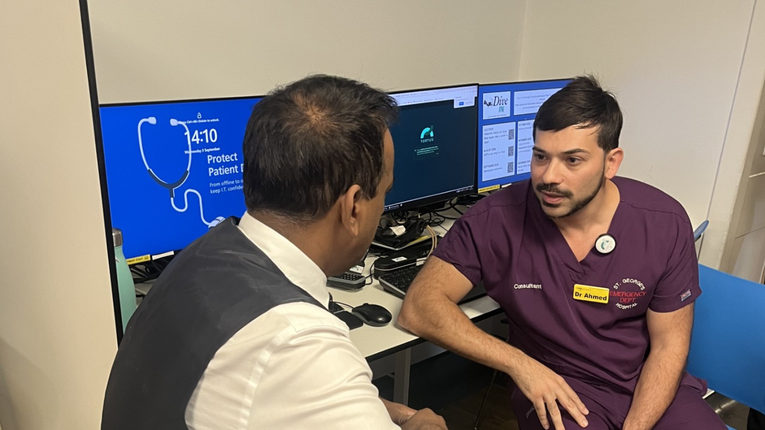
https://www.gosh.nhs.uk/news/investigating-the-rise-in-hepatitis-in-children/
Investigating the rise in hepatitis in children
25 Jul 2022, 12:15 p.m.
Across the world, there has been a recent increase in children who have hepatitis.
Due to our world-leading expertise in genomics, we teamed up with the UK Health Security Agency (UKHSA) to understand why more children than normal were being diagnosed with hepatitis.
Together with UCL Great Ormond Street Institute of Child Health (UCL GOS ICH), we've used highly specialised metagenomic techniques to better understand the reasons behind this spike.
What is hepatitis?
Hepatitis is the term used to describe inflammation of the liver, and is usually caused by a viral infection. There are five main types of hepatitis caused by specific viruses. These are known as A, B, C, D and E.
Symptoms of hepatitis in children can include:
- abdominal pain
- nausea
- yellowing of the eyes and skin (jaundice)
- a high temperature
Some types of hepatitis can pass without any serious problems, while others can be cause more serious damage.
A spike in hepatitis infections in 2022
Across the world, there has been a recent increase in children who have hepatitis. While still rare, hepatitis cases have been reported in 35 countries and nearly 200 children have now been admitted to hospitals in the UK. Several of these children have required emergency liver transplants for rapid liver deterioration.
However, none of the usual hepatitis causing viruses appear to have caused the liver disease seen recently in children.
Collaborating to find answers
Doctors and scientists are keen to understand the reason behind this spike in hepatitis infections.
To identify which virus may be driving the increasing case numbers, GOSH Department of Microbiology, together with UCL Genomics Pathogen Sequencing Group based in the Zayed Centre for Research, are providing help to the UK Health Security Agency (UKHSA).
This team is among just a handful of laboratories in the world able to provide these highly specialised services. These two departments from GOSH and UCL have a history of working together, that was bolstered by the pandemic, to analyse samples from children and adults with rare and unknown infections.
While teams in London studied cases in collaboration with the UKHSA, a team of Scottish researchers ran their own study in partnership with Public Health Scotland. Together, these two studies have helped provide answers to the rise in unknown hepatitis cases in children.
Results
Both the studies, lead independently and simultaneously by the Scottish and London teams, found that the common virus AAV2 (adeno-associate virus 2) was found at high levels in patients with unexplained hepatitis.
The virus, which is not known to normally cause disease and often accompanies infection with adenoviruses, has now been found by scientists to be associated with the development of acute hepatitis in a small number of young children.
AAV2 was present at high levels in all but one sample from patients with unexplained hepatitis and so the researchers believe that coinfection with two viruses – AAV2 and an adenovirus, or less often the herpes virus HHV6 (which has also been found in sample from some patients) – may offer the best explanation for the onset of severe liver disease in affected children.
Both studies were able to rule out the likelihood of recent or previous COVID-19 infection as a direct cause for the hepatitis cases.
Researchers still cannot be certain why this is happening now, but both teams have highlighted the possibility that a peak in adenovirus infections in the general population after a period of lockdown may have led to this, through lowered immunity in children to certain viruses and changes in patterns of virus circulation.
International collaborations to further investigate and elucidate the role of AAV2 and co-infecting viruses in paediatric unexplained hepatitis in patients from different countries are now needed.
Using metagenomics to identify a cause
In this project, the team used adenovirus and metagenomic sequencing services to help explain the emerging cases of unexplained hepatitis.
Metagenomics is a highly specific sequencing technique and is used to help detect infections in samples where an infectious disease is suspected, but nothing has been found using conventional testing.
Thanks, in part, to early funding from GOSH Charity, GOSH Microbiology, together with UCL, established the metagenomics service in 2019 to support the diagnosis of severe infection in children. They now process over 100 samples a year from children and adults from around the world. They also provide routine adenovirus sequencing to help identify transmission of infections and drug resistance.
During this investigation, the team studied 28 cases, including liver samples from five children that required a transplant and blood samples from the remaining children who did not.
RNA sequencing of liver samples confirmed the presence of AAV2 replication in the liver of children with unknown hepatitis. Patient samples were also compared with control samples of immunocompromised and immunocompetent patients. This showed that AAV2 was present only very rarely in the children who did not have hepatitis and at much lower levels, even for immunocompromised children.
We are very proud to use our collaboration to support this national and international effort. It’s particularly rewarding that we can use specialist expertise, which we have built-up to support children at GOSH, to help investigate a global emergency, particularly affecting children in the UK at the moment.
Meet the team researching the hepatitis spike
Dr Sofia Morfopoulou, Henry Wellcome Fellow (UCL) and Dr Julianne Brown, Principal Clinical Scientist (GOSH Microbiology) led the development of metagenomics testing to identify any new pathogens present. Dr Afonso Guerra Assuncao (Post Doc UCL) with Dr Rachel Williams, Head of Sequencing at UCL Genomics, lead the development of adenovirus sequencing. They have been working together with Dr Nathaniel Storey, senior bioinformatician at GOSH Microbiology, and UKHSA to identify the pathogens involved in the recent outbreak. The viral sequencing programmes at UCL/GOSH are headed by Professor Judy Breuer.
The UCL Genomics Pathogen Sequencing Group were supported to develop these services by the NIHR UCLH Biomedical Research Centre and the NIHR GOSH Biomedical Research Centre, while GOSH Microbiology received funding from GOSH and GOSH Charity.
Learn more about the team investigating the rise in hepatitis cases in Scotland.
Learn more

Scientists discover clues to help children with rare muscle disease
New ground-breaking research by experts at Great Ormond Street Hospital (GOSH) and University College London (UCL) has led to an exciting discovery that could help children with the rare muscle disease, juvenile dermatomyositis (JDM).

GOSH-led trial of AI-scribe technology shows ‘transformative’ benefits for patients and clinicians across London
A major GOSH-led study has found that AI-scribing technology can significantly reduce clinician workload while improving patient care

GOSH marks Childhood Cancer Awareness Month
Join us in the Lagoon on 3, 4 and 30 September between 11am and 2pm for a range of activities to mark Childhood Cancer Awareness Month.

What do bush babies, tamarin monkeys, and mouse lemurs have that humans don’t?
GOSH imaging researchers have worked with teams in Harvard in the USA to work out how and when our pelvises developed to be different from other animals.